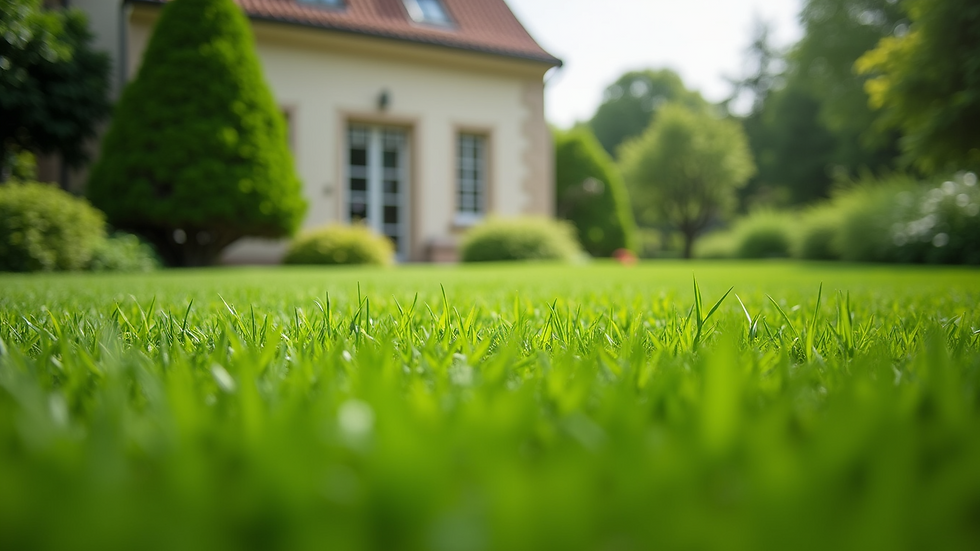Eco-Friendly Lawn Care for Sustainable and Healthy Yards
- gmarketingaustrali
- Sep 4
- 3 min read
Maintaining a lush, green lawn is a goal for many homeowners, but traditional lawn care methods often involve chemicals and practices that harm the environment. Fortunately, there are green lawn solutions that promote sustainability while keeping your yard healthy and vibrant. This guide explores practical, eco-conscious ways to care for your lawn, helping you reduce your environmental footprint and enjoy a beautiful outdoor space.
Understanding Green Lawn Solutions
Green lawn solutions focus on sustainable practices that nurture your lawn without damaging the ecosystem. These methods prioritize soil health, water conservation, and natural pest control. By adopting these strategies, you can create a thriving yard that supports local wildlife and reduces pollution.
Some key principles of green lawn solutions include:
Soil health improvement: Using organic compost and natural fertilizers to enrich the soil.
Water efficiency: Implementing smart irrigation techniques to minimize water waste.
Natural pest management: Encouraging beneficial insects and using non-toxic treatments.
Native and drought-resistant plants: Choosing grass types and plants suited to your local climate.
These approaches not only benefit the environment but also reduce maintenance costs and improve the resilience of your lawn.

Practical Tips for Sustainable Lawn Care
To implement green lawn solutions effectively, consider the following actionable steps:
1. Choose the Right Grass Type
Selecting grass species that are native or well-adapted to your region reduces the need for excessive watering and chemical inputs. For example, in many Australian climates, Kikuyu and Buffalo grass are popular choices due to their drought tolerance and hardiness.
2. Mow Smartly
Mowing your lawn at the correct height encourages deep root growth and helps retain moisture. Avoid cutting more than one-third of the grass blade at a time. Leaving grass clippings on the lawn acts as a natural fertilizer, returning nutrients to the soil.
3. Water Wisely
Water your lawn early in the morning or late in the evening to reduce evaporation. Use drip irrigation or soaker hoses to target the roots directly. Installing a rain sensor or moisture meter can prevent overwatering.
4. Fertilise Naturally
Replace synthetic fertilisers with organic options like compost, manure, or seaweed extracts. These improve soil structure and provide slow-release nutrients that support long-term lawn health.
5. Manage Weeds Organically
Hand-pulling weeds or using natural herbicides such as vinegar solutions can control unwanted plants without harming beneficial insects or soil life.
6. Encourage Biodiversity
Planting native flowers and shrubs around your lawn attracts pollinators and beneficial insects that help control pests naturally.

Tools and Techniques for Eco-Friendly Lawn Care
Using the right tools and techniques can make sustainable lawn care easier and more effective. Here are some recommendations:
Electric or battery-powered mowers: These produce less noise and zero emissions compared to petrol mowers.
Mulching mowers: They finely chop grass clippings and return them to the lawn, reducing waste.
Soil testing kits: Regular soil tests help you understand nutrient levels and pH, guiding your fertilisation strategy.
Aerators: Aerating your lawn improves water penetration and root growth by reducing soil compaction.
Compost bins: Creating your own compost from garden waste reduces landfill and provides nutrient-rich material for your lawn.
By integrating these tools into your routine, you can maintain a healthy lawn with minimal environmental impact.
Benefits of Eco-Friendly Lawn Care
Adopting eco-friendly lawn care practices offers numerous advantages beyond just a beautiful yard:
Environmental protection: Reduces chemical runoff into waterways and lowers carbon emissions.
Water conservation: Saves significant amounts of water, especially important in drought-prone areas.
Healthier soil: Promotes beneficial microorganisms and improves soil fertility.
Cost savings: Lowers expenses on water, fertilisers, and pest control products.
Enhanced biodiversity: Supports local wildlife, including birds, bees, and butterflies.
Improved air quality: Reduces pollutants and dust through natural vegetation.
These benefits contribute to a more sustainable lifestyle and a healthier planet.

Maintaining Your Sustainable Lawn Year-Round
To keep your lawn thriving throughout the seasons, follow these seasonal care tips:
Spring: Rake leaves and debris, aerate the soil, and apply organic fertiliser to encourage new growth.
Summer: Water deeply but infrequently, mow regularly at a higher setting, and monitor for pests.
Autumn: Overseed bare patches with drought-tolerant grass, reduce watering, and prepare the lawn for cooler weather.
Winter: Minimise foot traffic to prevent soil compaction, clear fallen leaves, and plan for spring improvements.
Regular maintenance aligned with seasonal changes ensures your lawn remains resilient and healthy.
By embracing green lawn solutions, you can enjoy a vibrant, sustainable yard that benefits both your home and the environment. Start small with simple changes and gradually adopt more eco-friendly practices to transform your lawn care routine. For expert advice and tailored solutions, consider reaching out to professionals who specialise in sustainable landscaping.
Your lawn can be a beautiful example of environmental stewardship and natural beauty. Take the first step today towards a greener, healthier outdoor space.




Comments